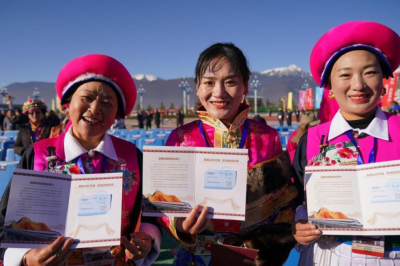Sept. 14, 2016 -- With its snowcapped Himalayan peaks and pristine glaciers, it is no surprise Tibet has become a rising star in the bottled water industry. By 2020, southwest China's Tibet Autonomous Region will be able to produce 5 million tonnes of bottled water per year with potential market value of 40 billion yuan (6 billion U.S. dollars), regional government chairman Losang Jamcan said at the Tibet Natural Drinking Water Industry Development Summit on Monday. More than 260 Chinese and international professionals and experts in the drinking water industry have spoken at the event in Lhasa on topics including Tibet's natural water resources, inspection and quarantine, investment and cooperation, logistics and marketing. Positioned on the world's highest plateau, Tibet is often called "Asia's water tower," and many of the world's greatest rivers flow out of the region. Unlike the rest of the country, which struggles with water shortages and pollution, Tibet boasts a clean environment and a large repository of fresh water. Water originating in Tibet is recognized as some of the best in the world based on quality testing. China is now the second largest country for packaged drinking water following the United States in market value. The country's market size is nearly 100 billion U.S. dollars, while the average annual growth in demand is about 15 percent, indicating a bright future for the industry, according to the summit organizers. Tibet produced about 426,000 tonnes of natural drinking water in 2015, up 178 percent year on year. So far, the region has 30 mineral water bottling lines with combined production capacity of 2 million tonnes a year. According to a 10-year plan for water industry development introduced by the regional government last year, Tibet has identified its fresh water resources as a new sustainable economic growth pillar with potential to support poverty reduction. Last year, a 250-million-yuan fund to support the industry was set up by the regional government, which also signed a logistics agreement with railway authorities to greatly lower the transportation costs for water companies. With improvements in major infrastructure in the region, more companies and funds, both foreign and domestic, have set up business in Tibet. Several hundred local Tibetans work in the factories of Wahaha Group, a major drinking water packager in China, since the factories were put into operation in 2011. "We are actively developing new health drinks using local specialties such as highland barley so consumers can have more options," said Wang Jian, deputy general manager of Wahaha. Jesper Bjorn Madsende, global executive director of Tibet 5100 Water Resources Development Co., said brand building is the heart of water resources development in Tibet, a view echoed by representatives from global drinking water giants such as Coca Cola, Nestle, Danone and Pepsi. |
- Home
- News Tibet |Exclusive |China |World |Related News |Latest
- Documents White Papers |Others
- Photo Politics |Economy & Society |Culture & Religion |Human & Nature |Beautiful Tibet |Other Tibetan-Inhabited Area |Exchanges |Related
- Video News |Documentary |Micro-Video |Entertainment
- Art
- Tourism
- In Focus
- About Tibet






